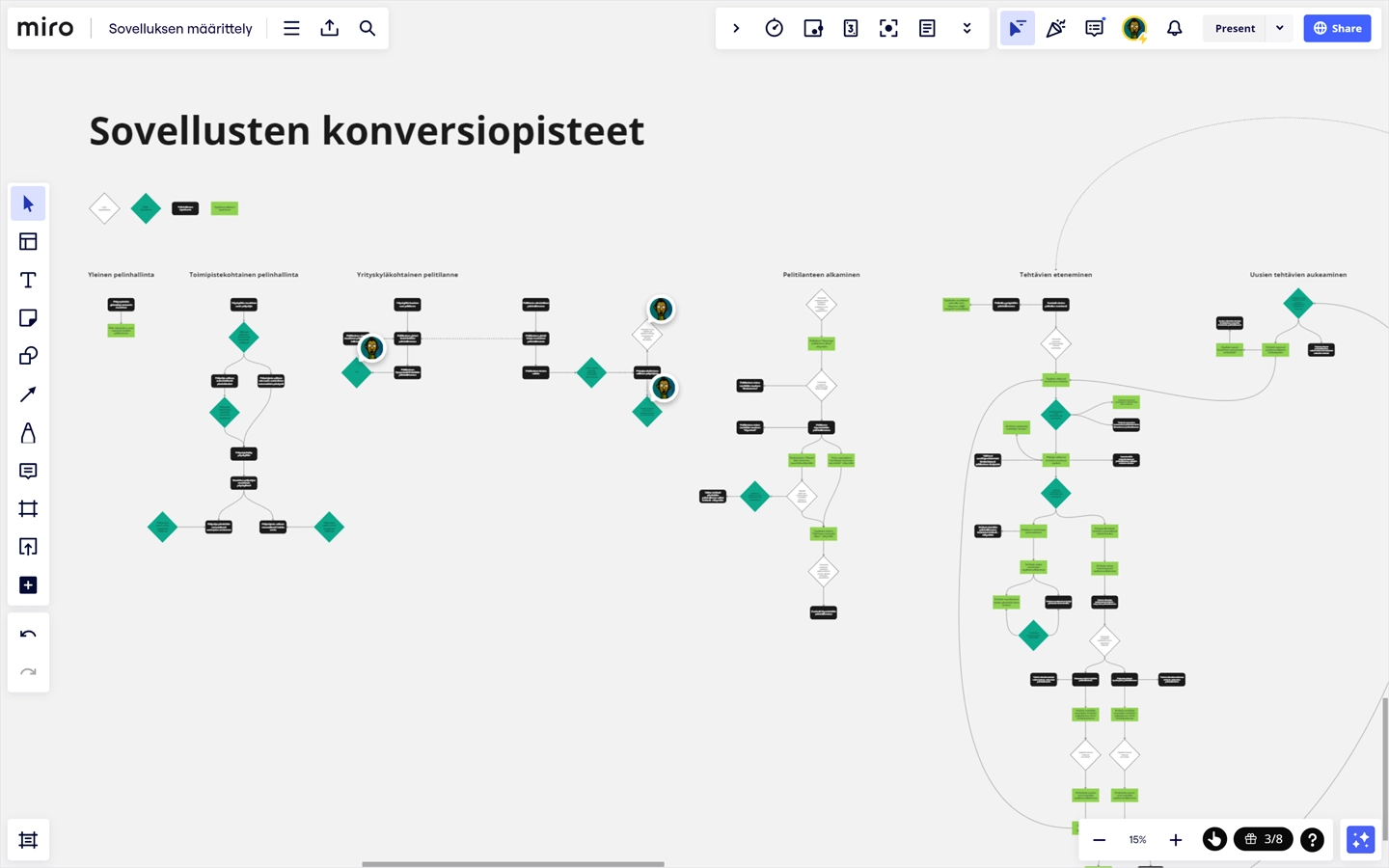Service Design
Developing our initial ideas into clear-cut feature solutions could be the most important component of any given product development.
Before moving forward, we should always define our goals and how we aim to achieve them. We must identify our feature solutions before drawing a single frame, while also meeting client and user needs via digital Service Design. The work that we intend to develop must always have some value, and as such, necessitates extensive field specific understanding and knowledge of user behavior.
Feature requirements
Internalizing initial specifications and feature demands.
Typically, digital service development initiatives begin with well documented external feature requirements or by creating such demands through proof-of-concept design and comprehensive workshop facilitation. My role as a designer includes digesting and breaking down this information into solid and achievable feature solutions and functional components. With my design experience, I assist us in sanity checking given needs and, in collaboration with all of our project team members, transforming them into fully fledged feature specifications before moving forward.

Client service bid documents with detailed and project specific initial requirements.
Understanding field specific traditions and user based needs.
Accepting and executing early ideas into working service solutions is generally inadequate. Getting completely immersed in situational goals and project realities enables me to successfully evaluate and, if necessary, challenge established requirements in order to better serve both our end user and client goals. In the field of digital products, each of our services must provide some value. And I'm here to help us make it happen.
Detailed specifications
Breaking external feature demands into technically sound solutions.
Knowing what we want to accomplish is critical for understanding how to best perform these functions in digital form. We have to process all possible components and content types, as well as any cross-service integrations or content management requirements, into precise service feature specifications. By breaking down these conditions into technically sound solutions with standardized techniques, we may specify our recommended implementation methods in a comprehensive and viable manner.

Identified service feature requirements during the collaborative specification and solution design phase.
Keeping technical needs and project realities as the driving force behind our design.
Clearly defining feature-specific approaches allows us to move on with our design in a manageable way. With my experience, I am more than capable of implementing realistic features and, working with our project team's technological expertise, can break everything down into readily developable form. Knowing how to transform given features into working components and identifying content-based relationships enables us to design functional services in a technically sound manner while keeping our suggested solutions within budget and resource constraints.
User flow design
Achieving operational objectives with effortless user experiences.
It makes no difference how realistic our technical solutions are if the user experience does not meet our end users' needs. Balancing the range of our service goals to suit both end users and client-set operational objectives necessitates careful consideration. To achieve these goals, we must transform our service structure into an efficient and value-driven experience with clearly defined and functioning user flows. Taking into account every possible corner case situation.

Project service flow design for an eccomerce solution with content specific outlines and relations.
Building complete user flow maps and structural definitions.
Converting precise feature specifications into fully usable service architectures must be a critical step in any service development process. Accounting for informational and content-driven sitemap structures affects everyone in our project team, from clients to Service Designers and Developers. When it comes to service function flow design and action driven structure relations, it is my time to shine.
I work methodically to fix the fundamental core of our service so that we can meet all of our previously defined needs. Planning how our service's features interact and how the customer is guided through desired actions necessitates that I carefully lay out the entire service structure in a straightforward and simply iterable form. Together with our development team, I have to identify all feasible user routes and action-based content variations. Finally, we can validate our service logic and recommended solutions before moving on to the actual layout design.
Service architecture
Identifying cross service functionalities and further use cases experiences.
With up-to-date digital services, simply understanding what happens within the service is rarely sufficient. More often than not, we must understand how the service fits into the bigger situation at hand. Naturally, everything from cross-service content and information relations to our client's operational structure and the services' location within it must be taken into account.

Service architecture design for a digital game platform with detailed cross service and live event actions accounted for.
How different services interact.
As a designer, it is not my responsibility to actually implement any technical or operational integrations. However, it is critical that I grasp the ramifications of these interactions and can respond appropriately within my design.
I must understand everything from integrated content pulls and actions to operational variables and tailor our solutions to meet said demands. How do these instances influence our user behavior, and what types of use cases do they generate with the service itself? Comprehensive design necessitates that I always observe and accommodate our solutions outside my immediate areas of responsibility. Building exceptional digital products is a collaborative endeavor, and I am delighted to be a part of it.
Scope management
Keeping our solutions within realistic and profitable frames.
Our product development goals can range from business-critical solutions to non-profit content or auxiliary services for charitable organizations. At the end of the day, my job must adhere to business realities and be profitable and reasonable. Maintaining a budget for both our proposed solutions and my own layout work is always essential.

Design backlog of detailed task estimations broken down in a project phase and component specific sections.
Designing solutions for the resources and budget at hand.
Budget concerns must always be considered from the start and will shape our eventual service feature specifications. The solutions we develop for these specifications have to be done within set financial boundaries, and the same constraints must be considered during the actual layout design phase.
As a professional, I am partially accountable for the product's overall success and must account for everything from client and end user happiness to business financial realities. The entire project development process, from comprehensive feature specifications to my layout design interpretations and finally to actual development, must be completed within a realistic scope.
Naturally, we may come up with fascinating or otherwise valuable service solutions that cannot be easily accommodated within limited resources. Fortunately for us, we can always record future ideas for further development, and our ideas may even be good enough for the customer to include additional budget in the project midway through development.
Further reading
I play an integral role in your digital product development cycle and go through all of the necessary design stages on each and every project. Take a look at specific steps that particularly interest you, or go in deep and review all of my thoughts regarding the subject.

Making the most of my design expertise.
Having a solid foundation in a variety of concepts and design principles has allowed me to put my skills in good use.








Always open for further discussion.

Call, text, or message me on Whatsapp. I am happy to discuss future proposals with you.
+358 40 584 0104
Do you prefer longer messages? You can always send me an old-fashioned email.
ernesti.niemi@gmail.com